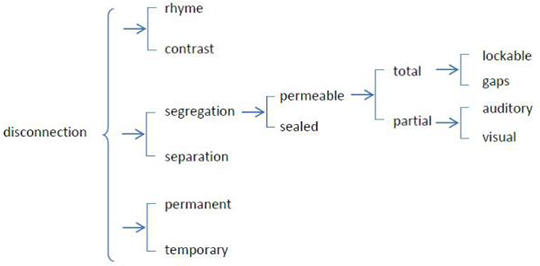In social semiotic multimodal theory, framing is seen as a multimodal resource for both separating and connecting represented entities. A frame can thus be used to signify that certain elements in a two-dimensional composition or in three-dimensional space are framed off from each other and hence disconnected, while other elements which occupy the same space (either inside or outside the frame) may be seen as belonging together.
The concept of framing was first introduced by Kress and van Leeuwen in Reading Images (1996: 214-218) as a compositional resource in visual communication, where framing can be realised in different ways. Most importantly, framing can be realised by different kinds of frame-lines as well as by empty space. Frame-lines can, for instance, be frames around an image within the larger composition of the page of a magazine, but they can also be constituted by represented elements in an image such as a wall or a tree. Empty space may likewise indicate that certain elements in the image are to be seen as somehow disconnected. Physical frame-lines are referred to as “segregation” (van Leeuwen 2005: 15-17), and the segregation may be more or less pronounced depending on the thickness of the frame. Framing by empty space, on the other hand, is referred to as “separation” (van Leeuwen 2005: 17) and may also vary in strength according to the amount of space between entities, however this means of framing is usually seen as weaker than physical frame-lines. In addition to physical frame-lines and empty space, Kress and van Leeuwen treat a number of other resources of connection and disconnection under the heading of “framing”: vectors, discontinuities of colour or shape, visual rhyme (i.e. the repetition of colour or shape) and other features (1996: 214-218 & 225).
Later, van Leeuwen (2005) shows that framing is, in fact, a multimodal resource by applying the concept to the interior design of open-plan schools and offices. Here, framing consists of physical elements such as walls, doors, curtains, free-standing partitions, green plants and desks as well as by different degrees of empty space between furniture, etc. Based on the data which is analysed in this particular context, van Leeuwen further develops the systematic description of framing devices by introducing concepts such as “permanence” (e.g. fixed walls vs. removable partitions) and “permeability” (in terms of either sound or vision).

Theo van Leeuwen’s system network for “the framing of space in schools and offices” (2005: 18)
In an application of the concept of framing in another institutional context – i.e. the architecture and interior design of a university building – Boeriis and Nørgaard (2013) confirm the usefulness of the system of framing in such and similar contexts, but also suggest adjustments of the system in view of the buildings analysed. It is thus suggested that the concept of permeability should be extended in order to capture the fact that frames may be permeable or sealed to movement as well as to sound and to sight, and that these choices are simultaneously possible and not a matter of either/or as initially suggested by van Leeuwen’s system network above.
In speech, the concept of framing may be applied to the different types of break which occur between rhythmic phrases, or “breath groups”, as well as to the pauses between the moves in communication, just as sonic framing can be identified in music (see entry on “Rhythm”). The following quotation from Reading Images neatly illustrates how framing and rhythm combine and may be seen as multimodal semiotic resources in time-based text:
In temporally integrated texts framing is […] brought about by rhythm. From time to time the ongoing equal-timed cycles of rhythm are momentarily interrupted by a pause, a rallentando, a change of gait, and these junctures mark off distinct units, disconnect stretches of speech or music or movement from each other to a greater or lesser degree. Where such junctures are absent, the elements are connected in a continuous flow. (Kress and van Leeuwen 2006: 203)
While framing is clearly a useful concept in multimodal analysis, it might be discussed whether it is the most suitable uniting category, covering not only the framing done by actual frame lines and empty space in visuals and three dimensional space, but also the connective and disconnective devices of “visual rhyme” and “contrast”.
Citing this entry
Nørgaard, Nina. 2016. “Framing.” In Key Terms in Multimodality: Definitions, Issues, Discussions, edited by Nina Nørgaard. www.sdu.dk/multimodalkeyterms. Retrieved dd.mm.yyyy.
References
Boeriis, M. and Nørgaard, N. (2013). “Architectural Discourse: The material realization of framing and discourse in a university building”, RASK 38, pp. 71-100. http://www.sdu.dk/en/om_sdu/institutter_centre/isk/forskning/forskningspublikationer/rask/issues/38/boeriis-noergaard
Kress, Gunther and van Leeuwen, Theo (1996). Reading Images: The Grammar of Visual Design (1st ed.). London and New York: Routledge.
Kress, Gunther and van Leeuwen, Theo (2006). Reading Images: The Grammar of Visual Design (2nd ed.). London and New York: Routledge.
van Leeuwen, Theo. 2005. Introducing Social Semiotics. London and New York: Routledge.